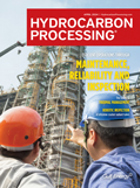Emerson's vision to break down silos and bring boundless automation
Story by: Tyler Campbell, Managing Editor, H2Tech
At the Emerson Exchange Immerse 2023, Emerson displayed its various technologies and contributions to its partners and users. The opening briefing focused on process control systems and software solutions, such as DeltaV Automation Platform, Ovation and AMS Machine Works. Claudio Fayad, VP, Technology, Process Systems and Solutions for Emerson, kicked things off by providing an update on the company’s Boundless Automation Vision, which regards breaking down silos.
Historically, horizontal silos consisted of process control, safety and reliability, while vertical silos had data broken down in a hierarchy. Simplifying the network (breaking silos) brings several software applications together in one platform, democratizing the data, increasing efficiency and asset optimization.
The DeltaV platform combines Emerson’s distributed control system (DCS) and safety instrumented system (SIS) with remote terminal units (RTUs), supervisory control and data acquisition (SCADA), manufacturing execution systems (MES) and operations management systems into one brand, DeltaV. The result is a system aimed at unifying its portfolio, combining expertise and delivering consistent experiences to shape the future.
After laying the groundwork, Fayad was joined on stage by Erik Lindhjem, VP of Reliability Solutions for Emerson. Lindhjem discussed intelligent field innovations, which is the ability to streamline information. According to Lindhjem, the DeltaV IO.Connect reduces modernization capital expenditure (CAPEX) by 40% and enables a simple transition to bring an existing input/output (I/O) into the field. The rapid streamlining of information can help operators monitor equipment performance and manage safety systems in a refinery.
Lindhjem went on to discuss several other integrated technologies, such as introducing PROFINET to the DeltaV PK Controller, which can use the advanced physical layer (APL) to accelerate the adoption of high-speed devices in process environments—additionally, the AMS device manager, which has been on the market for several years. The device can configure devices, manage alerts and calibrations remotely.
Its only drawback was the layers that separated the access to data. The AMS device manager provides an information technology (IT)-friendly format using operational technology (OT) data. It can be integrated with other data sources for advanced analytics and machine learning, continuously automate field device information and detect underperforming equipment with a secure network.
Finally, wireless devices (e.g., WirelessHART) take sensor information and share it in systems. Emerson intends to enable its wireless devices to do this with 5G. “Think about a gateway that’s collecting and aggregating many sensors within a facility; now, to be able to send that on an Ethernet connection, but also being able to do that over a public or private 5G network,” Lindhjem said. “Even on the long-range distributed assets, things that are geographically dispersed, being able to switch it to long-range LTE technology using NB-IOT and making that information available.”
Fayad returned to centerstage to discuss how IT and OT innovations can come together. One of the notable platforms was the Edge, which simplifies the network, democratizes data and enhances security while keeping the plant available and safe. Democratizing data means the data is available and can be used by anyone, reducing the storage of incoherent data often thrown away. Emerson’s hyperconverged infrastructure (HCI) prevents the need for multiple servers or dedicated storage; up to four servers across various locations can operate together using this platform.
“For us, the adoption is very important because this is the foundation block for a software-defined datacentric system,” Fayad said. “This is the foundation component that is going to allow all the different workloads (process control, reliability) to run on a single platform.”
DeltaV DCS enhances OT connectivity and runtime capabilities, bridges IT and OT technologies and policies and enables remote centralized fleet management. Emerson has also been working with AspenTech to integrate their Historian, advanced control and analytics platforms to run on the HCI. Adding AspenTech capabilities to DeltaV’s advanced control enables the coverage of broader applications and sizes.
Another one of Emerson’s technologies highlighted by Fayad was the Guardian. Guardian is a software and subscription lifecycle management and support tool. The tool allows the user to see all subscriptions, billing, lifecycle software and services and product support in one location.
Fayad ended his presentation with the topic of artificial intelligence (AI). The company is exploring how generative AI can give personnel copilots and help them generate configurations. For example, a plant can have hundreds of displays, and generative AI may be able to provide workers with a head start. Generative AI can also be utilized by operators, compiling multiple data sources to give an operator instructions when an alarm is triggered.
DeltaV Revamp uses an Emerson-trained AI to review the project library and develops up to 70% of the configuration. This information can be used to determine the control modules that must go on DeltaV. For the control modules that are not generated, it gives a narrative of what the module was supposed to do. DeltaV Revamp can provide near-instant project scope analysis, automate the migration of the base control layer, utilize machine learning (ML) generated rules and recommendations, reduce risk and CAPEX and improve schedule and efficiency.






Comments